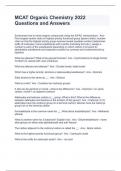Mcat organic chemistry - Study guides, Class notes & Summaries
Looking for the best study guides, study notes and summaries about Mcat organic chemistry? On this page you'll find 146 study documents about Mcat organic chemistry.
All 146 results
Sort by
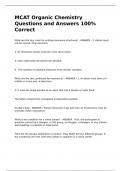
-
MCAT Organic Chemistry Questions and Answers 100% Correct
- Exam (elaborations) • 36 pages • 2024
- Available in package deal
-
- $14.99
- + learn more
MCAT Organic Chemistry Questions and Answers 100% CorrectMCAT Organic Chemistry Questions and Answers 100% CorrectMCAT Organic Chemistry Questions and Answers 100% CorrectMCAT Organic Chemistry Questions and Answers 100% CorrectWhat are the four rules for writing resonance structures? - ANSWER - 1. Atoms must not be moved. Only electrons. 2. All resonance atoms must lie in the same plane. 3. Only valid Lewis structures are allowed. 4 . The number of unpaired electrons must remain consta...
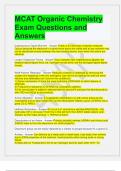
-
MCAT Organic Chemistry Exam Questions and Answers
- Exam (elaborations) • 20 pages • 2024
-
- $12.49
- + learn more
MCAT Organic Chemistry Exam Questions and Answers Instantaneous Dipole Moment - Answer-Exists in an otherwise nonpolar molecule. Occurs because the electrons in a bond move about the orbital and at any moment may not be distributed exactly between the two bonding atoms, even when the atoms are identical. London Dispersion Forces - Answer-Occur between two instantaneous dipoles; the weakest dipole-dipole force (vs. hydrogen bonds which are the strongest dipole-dipole forces). Wolff-Kishner...
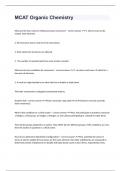
-
MCAT Organic Chemistry verified/passed
- Exam (elaborations) • 34 pages • 2024
- Available in package deal
-
- $19.99
- + learn more
MCAT Organic ChemistryWhat are the four rules for writing resonance structures? - correct answer 1. Atoms must not be moved. Only electrons. 2. All resonance atoms must lie in the same plane. 3. Only valid Lewis structures are allowed. 4 . The number of unpaired electrons must remain constant. What are the two conditions for resonance? - correct answer 1. An atom must have a P orbital or a lone pair of electrons. 2. It must be single bonded to an atom that has a double or triple b...
MCAT Organic Chemistry 2024 Questions and Answers
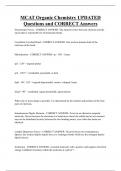
-
MCAT Organic Chemistry UPDATED Questions and CORRECT Answers
- Exam (elaborations) • 26 pages • 2024
-
- $9.99
- + learn more
MCAT Organic Chemistry UPDATED Questions and CORRECT Answers Electrostatic Forces - CORRECT ANSWER- The attractive force between electrons and the nuclei that is responsible for all molecular bonds. Coordinate Covalent Bond - CORRECT ANSWER- One nucleus donates both of the electrons in the bond. Hybridization - CORRECT ANSWER- sp - 180° - linear sp2 - 120° - trigonal planar sp3 - 109.5° - tetrahedral, pyramidal, or bent
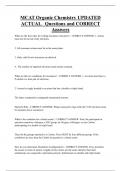
-
MCAT Organic Chemistry UPDATED ACTUAL Questions and CORRECT Answers
- Exam (elaborations) • 35 pages • 2024
-
- $9.99
- + learn more
MCAT Organic Chemistry UPDATED ACTUAL Questions and CORRECT Answers What are the four rules for writing resonance structures? - CORRECT ANSWER- 1. Atoms must not be moved. Only electrons. 2. All resonance atoms must lie in the same plane. 3. Only valid Lewis structures are allowed. 4 . The number of unpaired electrons must remain constan
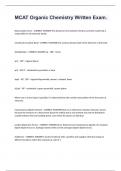
-
MCAT Organic Chemistry Written Exam.
- Exam (elaborations) • 27 pages • 2024
-
Available in package deal
-
- $12.99
- + learn more
MCAT Organic Chemistry Written Exam. Electrostatic Forces - CORRECT ANSWER The attractive force between electrons and the nuclei that is responsible for all molecular bonds. Coordinate Covalent Bond - CORRECT ANSWER One nucleus donates both of the electrons in the bond. Hybridization - CORRECT ANSWER sp - 180° - linear sp2 - 120° - trigonal planar sp3 - 109.5° - tetrahedral, pyramidal, or bent dsp3 - 90°, 120° - trigonal-bipyramidal, seesaw, t-shaped, linear d2sp3 - 9...
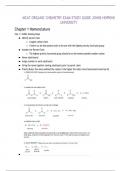
-
MCAT ORGANIC CHEMISTRY EXAM STUDY GUIDE JOHNS HOPKINS UNIVERSITY
- Exam (elaborations) • 29 pages • 2024
-
- $20.99
- + learn more
MCAT ORGANIC CHEMISTRY EXAM STUDY GUIDE JOHNS HOPKINS UNIVERSITY Chapter 1 Nomenclature Chp 1.1 IUPAC Naming Steps ● Identify parent chain ○ Longest carbon chain ○ If there is a tie then parent chain is the one with the highest priority functional group ● Number the Parnet Chain ○ The highest priority functional group should be on the lowest possible number carbon ● Name substituents ● Assign number to each substituent ● String the name together naming subsituents pr...
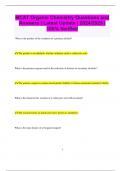
-
MCAT Organic Chemistry Questions and Answers | Latest Update | 2024/2025 | 100% Verified
- Exam (elaborations) • 50 pages • 2024
-
Available in package deal
-
- $11.96
- + learn more
MCAT Organic Chemistry Questions and Answers | Latest Update | 2024/2025 | 100% Verified What is the product of the oxidation of a primary alcohol? The product is an aldehyde. Further oxidation yields a carboxylic acid. What is the primary reagent used for the reduction of ketones to secondary alcohols? The primary reagent is sodium borohydride (NaBH4) or lithium aluminum hydride (LiAlH4). What is the characteristic reaction of a carboxylic acid with an amine? The reaction ...
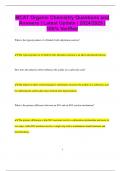
-
MCAT Organic Chemistry Questions and Answers | Latest Update | 2024/2025 | 100% Verified
- Exam (elaborations) • 65 pages • 2024
-
Available in package deal
-
- $11.96
- + learn more
MCAT Organic Chemistry Questions and Answers | Latest Update | 2024/2025 | 100% Verified What is the typical product of a Friedel-Crafts alkylation reaction? The typical product of a Friedel-Crafts alkylation reaction is an alkyl-substituted benzene. How does the inductive effect influence the acidity of a carboxylic acid? The inductive effect of electronegative substituents increases the acidity of a carboxylic acid by stabilizing the carboxylate anion formed after deprotonatio...

Study stress? For sellers on Stuvia, these are actually golden times. KA-CHING! Earn from your study resources too and start uploading now. Discover all about earning on Stuvia

